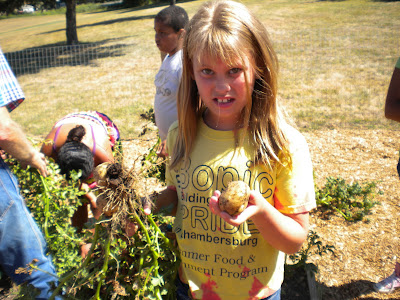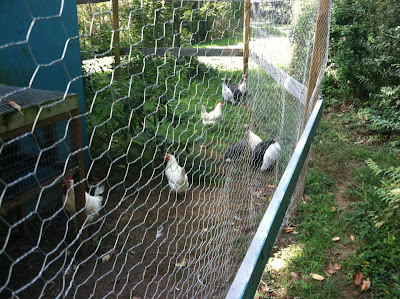Harvest 4-Health is a
Penn State Extension initiative to bring together multiple disciplines within Extension on a focused effort at the local level to teach the newest generation about growing their own, fresh, nutritious food by planning, planting, maintaining, and harvesting produce from their own vegetable gardens. Here in
Franklin County, PA, we teamed with an after school and summer program,
KLAS (Kids Learning After School), and key administrative, grounds and teaching staff at the
Thaddeus Stevens Elementary School in Chambersburg, PA.
KLAS is a year-round after school program for grades 1-6 (ages 6-12) consisting of 60 students usually broken into 3 groups of 20. School year runs mid September through mid May, with a summer term from mid June to the end of July. The cycle starts over again in mid September.
These 60 students have been the recipients of hands-on learning about what it takes to create a garden bed and grow your own vegetables, as well as a weekly curriculum in basic botany, soil science, pest and disease management, and healthy cooking and eating.
We staked out a 40x40 area in early April, 2011, conducted a
soil test and created six 5x10 raised beds (each group has two raised beds to manage) later in the month.
In early May, we filled the raised beds, planted seeds and plants ranging from 4-H strawberries, herbs, root crops, summer squash and cucumbers, potatoes, peppers and tomatoes. The vegetable plants were donated from Master Gardener starts, excess trial garden starts, and the
historic gardening effort sponsored by
Franklin County Master Gardeners and
Renfrew Institute’s Four-Square Garden Project.
The local newspaper, the
Chambersburg Public Opinion, covered planting day. An
excerpt:
Students in the Kids Learning After School program at Stevens Elementary are receiving first-hand experience with planting a vegetable garden, literally from the ground up.
The extension office, 4-H, and a group of Master Gardeners came together to provide this part of the program. Gardeners built a series of six raised flower beds to go behind the elementary school.
Penn State calls the effort Harvest 4-Health and it's a means to teach children healthy eating habits.
On Wednesday, Master Gardener Bill Dorman helped students plant potatoes, parsley, cabbage, strawberries, tomatoes, cauliflower, zucchini and marigolds in the bed. He gave gardening tips along the way.
KLAS is an after-school program provided by Title I funds at Stevens. It features students from Stevens and Ben Chambers Elementary.
In June, we battled groundhogs, losing most of the radishes, beans, carrots, and parsley to their nibbling, which forced us to build a fence in July to reduce the impact of their predations.
We started harvesting squash and potatoes at the end of the month. Final harvest and garden clean up took place at the end of September.
The effort has been lead by Barbara Aldrich, 4-H Educator, ably assisted by 4-H Summer Assistant Jaclyn Upperman, 4-H volunteers Jesse Reichard and Patrick Hurd, Dairy Educator Logan Hurst , and
Master Gardener volunteers Ray Eckhart, Bill Dorman, Karen Latsbaugh, George Fries, Darl Hospelhorn, and Anne Finucane. School administrators, including principal Richard J. Bonitz and Buildings and Grounds Supervisor, Jeff Roseberry have been very supportive, providing water access, mulch for pathways, etc. Dale Wolfson, Program Director for KLAS has provided logistical and $500 funding support, to go with another $500 funding from the
Franklin County 4-H and Master Gardener programs. Tanya Nitterhouse, neighbor and benefactor has also contributed toward the effort.
Penn State Extension Educators of Franklin County Ray Eckhart (Pesticide and Master Gardener), Mary Ann Oyler (Health and Nutrition), George Hurd (Environment), Alex Surcica (Horticulture and Pollination), Jennifer Bratthauar (Agronomy and Soil Science) and Barbara Aldrich (4-H) are providing classroom education in addition to the hands-on learning which reinforces it.
This has been a total team effort on the part of Penn State Extension, Franklin County, its volunteers, the neighborhood community, the school, and the KLAS operation. We hope to be able to replicate its success elsewhere in 2012.
Wish us luck.























































